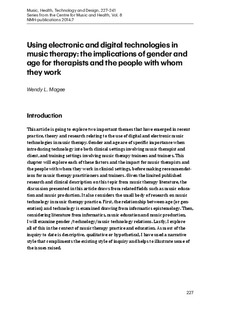Using electronic and digital technologies in music therapy: the implications of gender and age for therapists and the people with whom they work
Chapter, Peer reviewed
Permanent lenke
http://hdl.handle.net/11250/279900Utgivelsesdato
2014Metadata
Vis full innførselSamlinger
- Artikler og bokkapitler [390]
Originalversjon
I: Music, Health, Technology and Design, s. 227–241Sammendrag
This article is going to explore two important themes that have emerged in recent practice, theory and research relating to the use of digital and electronic music technologies in music therapy. Gender and age are of specific importance when introducing technology into both clinical settings involving music therapist and client, and training settings involving music therapy trainees and trainers. This chapter will explore each of these factors and the impact for music therapists and the people with whom they work in clinical settings, before making recommendations for music therapy practitioners and trainers. Given the limited published research and clinical description on this topic from music therapy literature, the discussion presented in this article draws from related fields such as music education and music production. It also considers the small body of research on music technology in music therapy practice. First, the relationship between age (or generation) and technology is examined drawing from informatics epistemology. Then, considering literature from informatics, music education and music production, I will examine gender /technology/music technology relations. Lastly, I explore all of this in the context of music therapy practice and education. As most of the inquiry to date is descriptive, qualitative or hypothetical, I have used a narrative style that compliments the existing style of inquiry and helps to illustrate some of the issues raised.
Utgiver
Norges musikkhøgskoleSerie
Series from the Centre for Music and Health;8NMH-publications;2014:7
